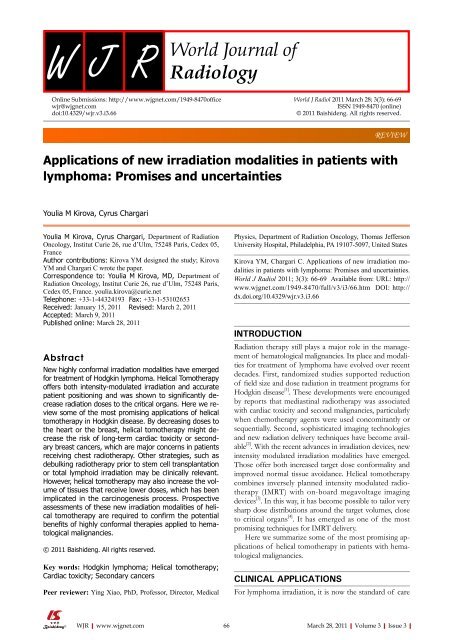3 - World Journal of Gastroenterology
3 - World Journal of Gastroenterology
3 - World Journal of Gastroenterology
Create successful ePaper yourself
Turn your PDF publications into a flip-book with our unique Google optimized e-Paper software.
W J R<br />
Online Submissions: http://www.wjgnet.com/1949-8470<strong>of</strong>fice<br />
wjr@wjgnet.com<br />
doi:10.4329/wjr.v3.i3.66<br />
Applications <strong>of</strong> new irradiation modalities in patients with<br />
lymphoma: Promises and uncertainties<br />
Youlia M Kirova, Cyrus Chargari<br />
Youlia M Kirova, Cyrus Chargari, Department <strong>of</strong> Radiation<br />
Oncology, Institut Curie 26, rue d’Ulm, 75248 Paris, Cedex 05,<br />
France<br />
Author contributions: Kirova YM designed the study; Kirova<br />
YM and Chargari C wrote the paper.<br />
Correspondence to: Youlia M Kirova, MD, Department <strong>of</strong><br />
Radiation Oncology, Institut Curie 26, rue d’Ulm, 75248 Paris,<br />
Cedex 05, France. youlia.kirova@curie.net<br />
Telephone: +33-1-44324193 Fax: +33-1-53102653<br />
Received: January 15, 2011 Revised: March 2, 2011<br />
Accepted: March 9, 2011<br />
Published online: March 28, 2011<br />
Abstract<br />
New highly conformal irradiation modalities have emerged<br />
for treatment <strong>of</strong> Hodgkin lymphoma. Helical Tomotherapy<br />
<strong>of</strong>fers both intensity-modulated irradiation and accurate<br />
patient positioning and was shown to significantly decrease<br />
radiation doses to the critical organs. Here we review<br />
some <strong>of</strong> the most promising applications <strong>of</strong> helical<br />
tomotherapy in Hodgkin disease. By decreasing doses to<br />
the heart or the breast, helical tomotherapy might decrease<br />
the risk <strong>of</strong> long-term cardiac toxicity or secondary<br />
breast cancers, which are major concerns in patients<br />
receiving chest radiotherapy. Other strategies, such as<br />
debulking radiotherapy prior to stem cell transplantation<br />
or total lymphoid irradiation may be clinically relevant.<br />
However, helical tomotherapy may also increase the volume<br />
<strong>of</strong> tissues that receive lower doses, which has been<br />
implicated in the carcinogenesis process. Prospective<br />
assessments <strong>of</strong> these new irradiation modalities <strong>of</strong> helical<br />
tomotherapy are required to confirm the potential<br />
benefits <strong>of</strong> highly conformal therapies applied to hematological<br />
malignancies.<br />
© 2011 Baishideng. All rights reserved.<br />
Key words: Hodgkin lymphoma; Helical tomotherapy;<br />
Cardiac toxicity; Secondary cancers<br />
Peer reviewer: Ying Xiao, PhD, Pr<strong>of</strong>essor, Director, Medical<br />
WJR|www.wjgnet.com<br />
<strong>World</strong> <strong>Journal</strong> <strong>of</strong><br />
Radiology<br />
Physics, Department <strong>of</strong> Radiation Oncology, Thomas Jefferson<br />
University Hospital, Philadelphia, PA 19107-5097, United States<br />
Kirova YM, Chargari C. Applications <strong>of</strong> new irradiation modalities<br />
in patients with lymphoma: Promises and uncertainties.<br />
<strong>World</strong> J Radiol 2011; 3(3): 66-69 Available from: URL: http://<br />
www.wjgnet.com/1949-8470/full/v3/i3/66.htm DOI: http://<br />
dx.doi.org/10.4329/wjr.v3.i3.66<br />
INTRODUCTION<br />
Radiation therapy still plays a major role in the management<br />
<strong>of</strong> hematological malignancies. Its place and modalities<br />
for treatment <strong>of</strong> lymphoma have evolved over recent<br />
decades. First, randomized studies supported reduction<br />
<strong>of</strong> field size and dose radiation in treatment programs for<br />
Hodgkin disease [1] . These developments were encouraged<br />
by reports that mediastinal radiotherapy was associated<br />
with cardiac toxicity and second malignancies, particularly<br />
when chemotherapy agents were used concomitantly or<br />
sequentially. Second, sophisticated imaging technologies<br />
and new radiation delivery techniques have become available<br />
[2] . With the recent advances in irradiation devices, new<br />
intensity modulated irradiation modalities have emerged.<br />
Those <strong>of</strong>fer both increased target dose conformality and<br />
improved normal tissue avoidance. Helical tomotherapy<br />
combines inversely planned intensity modulated radiotherapy<br />
(IMRT) with on-board megavoltage imaging<br />
devices [3] . In this way, it has become possible to tailor very<br />
sharp dose distributions around the target volumes, close<br />
to critical organs [4] . It has emerged as one <strong>of</strong> the most<br />
promising techniques for IMRT delivery.<br />
Here we summarize some <strong>of</strong> the most promising applications<br />
<strong>of</strong> helical tomotherapy in patients with hematological<br />
malignancies.<br />
CLINICAL APPLICATIONS<br />
<strong>World</strong> J Radiol 2011 March 28; 3(3): 66-69<br />
ISSN 1949-8470 (online)<br />
© 2011 Baishideng. All rights reserved.<br />
REVIEW<br />
For lymphoma irradiation, it is now the standard <strong>of</strong> care<br />
66 March 28, 2011|Volume 3|Issue 3|

















